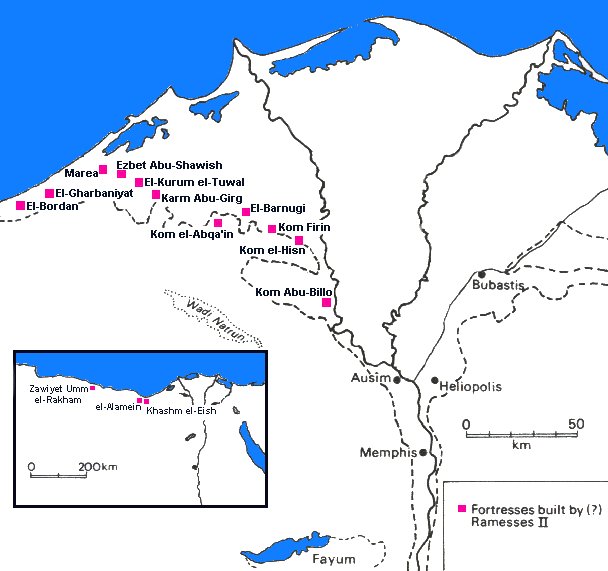
The map below shows the supposed location of the fortresses that make up the chain of defences established by Ramesses II to protect Egypt's western frontier from attack.

Unlike the defensive systems that protected Egypt's southern and eastern frontiers (for more info, follow the links) the western frontier defences have been subject to little comprehensive archaeological investigation. Thus, the exact nature of the fortifications, their function and even their location has remained a matter of conjecture until recently.
However, over the last twenty years, there has been a surge in activity on Egypt's western coast which is beginning to make it possible to revise existing ideas about ancient activity in the region.
Some of the most important evidence is coming from the ongoing excavations at Zawiyet Umm el-Rakham, on the Mediterranean coast, 320km west of Alexandria. This is the most westerly fortress currently known and the only to have undergone any large-scale investigation. Since 1994, work by the University of Liverpool has revealed a great deal not only about the fortress itself and the activities that took place there, but also about the wider Late Bronze Age Mediterranean world.
Today, Zawiyet Umm el-Rakham is a small village, with an economy largely based on agriculture, although the tourism boom on the Mediterranean coast is increasingly lucrative for the locals, as is the annual arrival of rich, western archaeologists, who descend on the village each September, renting accommodation, buying tools and ice-creams and paying very good wages.

Relatively little is known about the history of Zawiyet Umm el-Rakham. In Graeco-Roman times it was known as Apis, mentioned by several of the classical geographers, including Pliny the Elder and Strabo, by which point it lay at the extent of Egyptian government (Ball 1942:62,76; White 1999a:141-142). It may also be equated with the "House of the Bull" mentioned in the 30th Dynasty Western Desert geographical stela (Daressy 1916:225, 240-241; Rowe 1948:4-5). A number of tombs dating from the 26th Dynasty to the Roman period have been noted and investigated in the region (Habachi 1980:18-19; Leclant & Clerc 1987:293, 1993:176; White 1999a:142).
However, it is ZUR of the Late Bronze Age in which we are most interested.